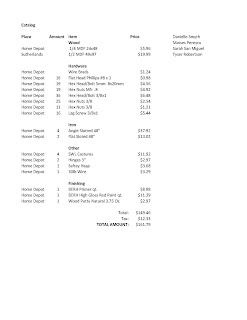
trobertson3501
Friday, October 22, 2010
Wednesday, September 29, 2010
Tuesday, September 28, 2010
Wednesday, September 22, 2010
Reading Detail & Poetry Questions
1. As the technique of detailing changed from the hands of the craftsman to the tools of the architect, how has the resulting construction of details changed? Explain in terms of scale, material and cost.
- The transition from detailing done by the hands of the craftsman to the tools of the architect has had a big impact on the role of these details. The personal, hands on, aspect of building the details has been lost with many architects with their use of drawing parts digitally and then having someone else build them. This has also cause a more diverse group of materials to be used, because the hand crafted aspect is done so rarely now. The cost of the details has lowered with the industrial revolution and the lost of the hands on aspect; if a detail is handmade now, the cost rises drastically.
2. How does "geometrical relationship" of individual details provide an understanding of the whole building if "indirect vision" localizes the viewer and "habit determines to a large extent even optical reception"?
- The “geometrical relationship” of individual details has a direct affect on the viewers understanding of the whole building. A continuity of the building details helps bring the building together as one complete composition and makes the structure more successful. These details reference each other, even when they are not all seen at the same time. This creates a relationship or language between the details and the different parts of the building that help viewers accept it as a whole.
3. Carlo Scarp's details are a "result of an intellectual game" where the Open City buildings are constructed from an act of poetry. Describe what role the detail plays to "tell-the-tale" in each of these environments.
- The details in Scarp’s work “tell-the-tale” in how the details are constructed and where they are placed. The details are the dominated factor in the influence of the spaces or building itself. The Open City buildings “tell-the-tale” in their relationship to the site. They do not focus on a specific building detail or symbolism, but rather they put an emphasis on uniqueness of each site and the poetic beauty of understanding that site.
4. Pendleton-Jullian writes about the Open City as emerging from and being in the landscape. Does allowing landscape to initiate "the configuration of territory and space" challenge Western building notions, and how so?
- Allowing the landscape to be the main point that dictates the space and configuration of a building definitely challenges Western building notions. Much of the time, Western practices look at how the site can be changed in order to allow for the configuration of space that the architect wants. Many times the site is viewed as there to be molded and changed to fit our buildings specifications, not the other way around.
5. Describe some detail conditions of the Open City that convey "lightness" as Pendleton-Jullian refers to.
- The Open City conveys “lightness” in both conceptually and in actual construction. Much of it is constructed with light timber framing and voids that create a sense of lightness; as well as a feeling of it being temporary or changeable, which plays into the conceptual lightness. This type of lightness is expressed through the light construction and special feelings of the structures, in contrast with buildings in other areas that are massive and have a certain weight to them.




